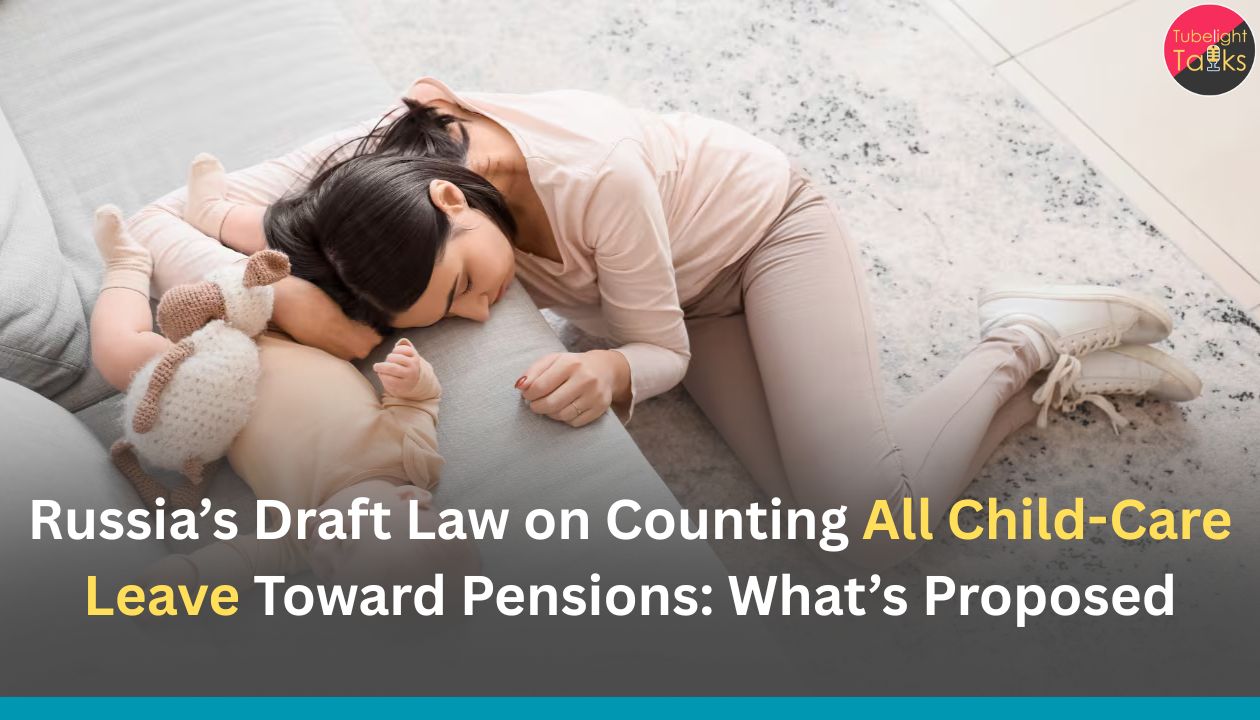Russia’s Draft Law: A widely discussed family-policy change is taking shape in Russia authorities have prepared a draft law to count all periods of child-care leave toward a parent’s insurance work record (used to qualify for and calculate state pensions), removing the long-standing 6-year cap. If enacted, the shift could materially improve future pension outcomes for stay-at-home mothers and large families.
Below, we explain what the current rules are, what the draft proposes, who gains, what implementation might involve, and how to separate viral posts from verified details, with links to official Russian sources and reputable reporting.
What the Russia’s Draft Law Says Today (Baseline)
Under current Russian rules, time spent caring for a child up to 1.5 years of age is credited toward a parent’s insurance record, which affects eligibility and calculation of pensions. However, only up to 6 years total (typically covering up to four children at 1.5 years each) can be counted.
Separate from the record itself, Russia’s pension formula assigns “points” (individual pension coefficients) for certain non-insurance periods, including child-care, with higher points for third and fourth children.
- Today’s cap: max 6 years of child-care leave counted toward the insurance record.
- Typical child-care durations credited: up to 1.5 years per child toward the record.
- Example points (reference values used in public guidance): 1.8 points for the first child’s 1.5-year period; 3.6 for the second; 5.4 for third and fourth.
What Is Being Proposed (Draft, Not Yet Law)
The Ministry of Labour has publicly said it prepared a bill to remove the 6-year limit so that all periods of child-care leave up to 1.5 years per child count in the insurance work record—with retroactive recalculation envisioned for eligible pensioners.
The Social Fund of Russia (SFR) confirms this direction and notes draft provisions to assign pension coefficients for each child without limiting the number; it also references enhanced recognition and payments for so-called “hero mothers.”
Key proposed changes, per official and semi-official briefings:
- Lift the cap: count all child-care leave periods (not just 6 total years) toward a parent’s insurance record.
- Recalculate: allow parents of many children who already retired to apply for pension recalculation.
- Coefficients: continue (and extend) assignment of pension points per child, recognizing the economic value of caregiving.
- Honours/Payments: align special monthly payments for “hero mothers” (10+ children) at the level granted to Heroes of Labour.
Independent coverage (January 2025) reported two maternity-support bills in this package: one on student-mothers’ benefits and another on counting all child-care leave in the insurance record.
Why It Matters: Five Practical Impacts
1) Stay-at-home mothers gain formal recognition
By crediting the work record for all child-care periods, the reform acknowledges unpaid caregiving as socially valuable. For mothers who paused paid work across multiple births, this reduces the likelihood of falling short of the minimum years/points needed for a full pension.
2) Large families see the biggest pension boost
Parents with three or more children receive higher coefficients for later births under current formulas; removing the cap means those periods no longer “stop counting” after six years. That directly raises future pension entitlements for many-child families.
3) Retroactive recalculations unlock money for some retirees
Draft language and ministerial briefings suggest already-retired large-family parents could apply to the Social Fund to recompute their insurance pension once changes are enacted, potentially increasing monthly payouts.
4) Administrative clarity for employers and the SFR
A clear statutory rule simplifies documentation: instead of counting and capping fragmented leave periods across births, the SFR can credit all eligible periods, streamlining processing and reducing disputes over record gaps.
5) Signalling effect in family policy
Beyond mechanics, the measure signals a policy shift: recognizing care as work that merits pension credit. This aligns with broader demographic aims while acknowledging the economic value of unpaid domestic labor.
What’s Not Changing (and Why That Matters)
Even if all child-care periods are counted toward the insurance record, pension size still depends on total pension points accrued across a lifetime (from contributions and credited non-insurance periods) and the fixed component. Counting more years helps with eligibility and may improve the payout if more non-insurance periods qualify, but the point accrual rules and caps remain central.
Eligibility and the “insurance work record”
The record is about years, not earnings levels
The insurance work record is the sum of insurance and non-insurance periods recognized by law (including child-care up to 1.5 years per child). You typically need a minimum number of years and a minimum number of pension points to qualify for a standard old-age insurance pension.
The 6-year cap is the pain point
Families with many children “hit the ceiling” after four children’s worth of leave, as only six total years of child-care can be credited—leaving uncredited caregiving time. The draft bill removes that ceiling.
Pension points (individual coefficients)
Points accrue from contributions and some “credited” periods
Each year of contributions (or recognized non-insurance periods) yields pension points up to an annual maximum. Child-care periods have fixed point values (e.g., 1.8, 3.6, 5.4), higher for the 3rd and 4th child. The draft continues this logic while lifting the 6-year cap on counting periods in the record.
Minimums still apply
To grant a pension, minimum points and minimum work-record years must be met; counting more child-care time helps many parents meet the thresholds.
Timelines and Legislative Path
- January 2025: Officials say a bill is prepared to remove the 6-year cap in the insurance record; messaging also mentions retroactive recalculations.
- June 2025 (SFR Board): The Social Fund of Russia publicly reiterates the draft bill approach (no cap; coefficients per child; “hero mother” recognition/payment).
- Autumn 2025: Lawmakers and ministry officials discuss refinements, with some emphasizing a step-by-step rollout and monitoring recent changes before expanding further.
Bottom line: As of November 13, 2025, the measure is best described as an advanced draft initiative with clear political backing, but final enactment, exact wording, and start date depend on the legislative process. Keep an eye on Ministry of Labour and SFR announcements for when it actually becomes law.
Implementation Questions (If/When It Passes)
How will retroactive recalculation work?
Likely application-based with SFR
Expect application procedures via the Social Fund for eligible retirees (e.g., mothers of many children) to request a pension recomputation. Details—what documents, how far back, processing times—will be in by-laws and SFR guidance.
Will fathers benefit?
Yes, where the father is the recognized caregiver
Existing frameworks credit the caregiver—not exclusively the mother—for eligible child-care periods. Clarifications will be needed in the final text to ensure gender-neutral application for primary caregivers. (Inference consistent with current SFR guidance on credited non-insurance periods.)
Interaction with maternity/parental leave durations
Durations remain as per labour code & SFR practice
Standard maternity-leave durations (e.g., 140 days, with extensions for complications or multiples) are separate from the 1.5-year child-care period credited per child. The draft focuses on counting all such 1.5-year periods toward the work record, not rewriting labour-leave durations.
International Lens: Recognising Care as Work
Many countries credit caregiving in pension systems to reflect unpaid social value. Russia already does this partially; the draft would scale up by removing the cap. This fits a broader demographic strategy to support families while tackling low birth rates, as seen in previous Russian moves like extended maternity capital through 2030 and adjustments to student-mother benefits.
Fast Facts: At A Glance
- Current rule: Child-care up to 1.5 years per child, max 6 years total, counts toward insurance record; fixed points credited per child.
- Draft change: Remove 6-year cap; count all eligible periods; recalculations for some retirees via SFR.
- Who gains most: Stay-at-home mothers and large families with >4 children.
- Caveat: As of Nov 13, 2025, this is a draft, pending passage and detailed procedures.
A Values Lens on Caregiving and Dignity
Recognising unseen work builds a healthier society Policy mechanics aside, this story is about valuing care. Unpaid caregiving sustains families and society, yet it often goes unrecognized in economic terms. Spiritual teachings from contemporary discourses of Sant Rampal Ji Maharaj, repeatedly emphasise truthful living, non-harm, service, and responsibility – virtues that map directly onto how a community treats caregivers.
When a system acknowledges care as work and ensures it doesn’t penalise mothers (or fathers) in old age, it aligns material policy with ethical balance: honouring duty, supporting family stability, and nurturing the next generation. Explore these teachings through the official website and talks for a deeper personal perspective on living with equanimity and service.
Also Read: “Italy is disappearing”: What the Viral Claim Reveals—and What the Numbers Actually Say
FAQs: Russia Weighs Pension Boost for Stay-at-Home Mothers
1) Is this already a law in force?
No. As of November 13, 2025, it is a draft bill publicly described by officials and reflected in SFR communications. Final enactment awaits the legislative process and official publication.
2) What exactly changes if it passes?
The 6-year cap on counting child-care leave in the insurance work record would be removed, so all 1.5-year child-care periods per child would be credited. Some retirees could apply for a recalculation.
3) Do fathers also qualify?
Where fathers are the documented primary caregivers, the credited period can apply to them; final wording will clarify procedures, but the framework is caregiver-based, not mother-only.
4) How do “points” (coefficients) fit in?
Russia’s pension uses points plus a fixed payment. Child-care periods earn fixed points (e.g., higher for the 3rd/4th child). The draft keeps that logic while ensuring all such periods count toward the work record.
5) What about leave durations—are they changing?
No change signalled: standard maternity-leave durations (e.g., 140 days standard; longer for complications/multiples) remain; the draft concerns work-record counting, not labour-leave length.
6) Where can I read reliable updates?
Follow the Social Fund of Russia (SFR) and Ministry of Labour notices. For context and coverage of the January 2025 briefings about removing the cap, see reports summarising official statements.










